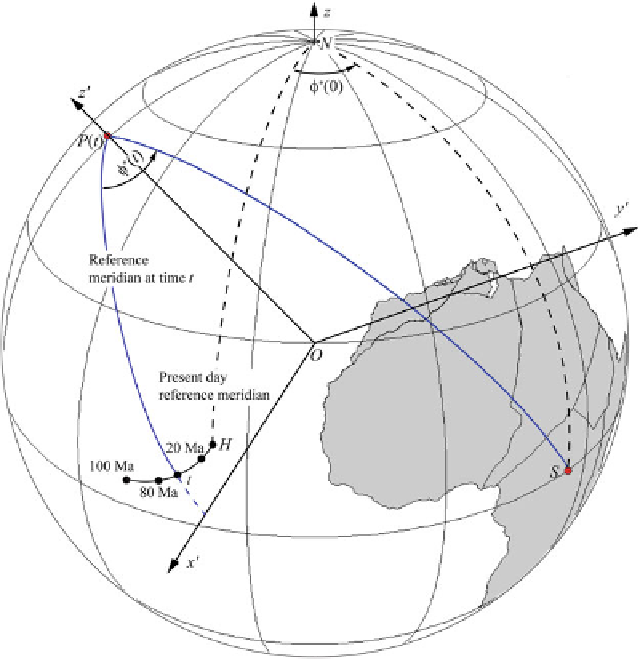Geology Reference
In-Depth Information
Fig. 6.17
The
paleolongitude
¥
*
(
t
)at
time
t
of a site
S
on the
reference continent (central
Africa in this example) in a
paleomagnetic reference
frame (
x
0
,
y
0
,
z
0
) is built
using the mean paleopole
P
(
t
) for time
t
and a hot
spot track. At any time
t
,
the reference meridian (i.e.,
the meridian for which
x
0
D
0) is defined as the
actual meridian of a hot
spot location,
H
(
t
), with
respect to
P
(
t
). It is
assumed that
H
is the
surficial expression of
deep processes and that its
location does not depend
from the motion of the
plate where it is currently
placed. The
black line
with
age progression of hot spot
locations represents the
track left by
H
during the
motion of this plate
A way to define the
paleolongitude
of a point
independently from plate motions is based on the
individuation of
hot spots
(Morgan
1971
) punc-
tual magmatic features at the Earth's surface,
which are expressions of deep processes occur-
ring somewhere below the lithosphere and the
uppermost asthenosphere (Fig.
6.17
). A key fea-
ture of hot spots, which is generally interpreted as
evidence of their stationary position with respect
to the mantle, is that they are placed at the
youngest ends of
alignments
of intraplate volcan-
ism with
age progression
. In this instance, the
combined sequence of magmatic events in space
and time could witness the transit of the tectonic
plates where they are placed over quasi-stationary
mantle upwellings not related to plate boundary
processes. Classic examples of
hot spot tracks
are the Hawaiian and Emperor seamount chains
on the Pacific plate. Contrarily to a widespread
belief, the construction of reference frames based
on hot spot tracks does not require assumption
that hot spots be fixed to the deep mantle, be-
cause
any
marker whose geographic location is
unconstrained with respect to the surrounding
plate and with sufficient age range can be used
to define paleolongitudes. Figure
6.17
illustrates
how to accomplish this task. If
H
is the present
day location of a hot spot, we choose an arbitrary
reference site
S
on the root plate and determine its
relative longitude, ¥*(0)
D
¥
S
-¥
H
, with respect
to
H
. To calculate the paleolongitude at time
t
,
we choose as reference meridian in the paleo-
magnetic reference frame (
x
0
,
y
0
,
z
0
) the meridian
passing through the location,
H
(
t
), where the hot
spot magmatism has age
t
. The paleolongitude
¥
*
(
t
) will be given by the angle between the
meridian through
S
and the reference meridian
in
the paleomagnetic frame
. Therefore, the
longitu-
dinal shift
of the reconstructed site
S
is given by
•
¥
(
t
)
D
¥
*(
t
)-
¥
*(0).
Hot spot tracks are useful to set up paleo-
magnetic or pure hot-spot reference frames for

